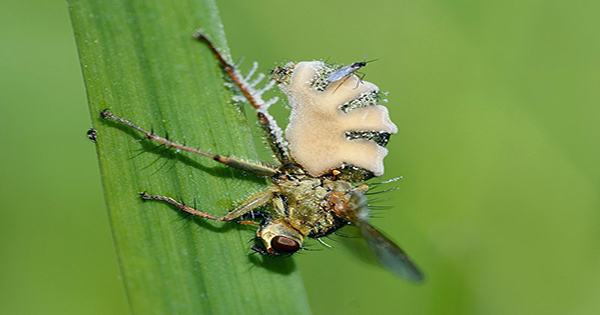The fungus has a penchant for zombifying insects and modifying their behavior in order to increase their own spread potential. It will sometimes use imitation to trick lustlorn bugs into making large, moldy blunders, but they are not known to use both methods at the same time.
Now, according to preprint research, a fungus achieves just that, causing its host to die on the highest point before modifying the chemical signals of the body to attract male attention. The male’s unknowing necrophilia exposes him to infection when he mates with the dead, causing the fungus to spread further.
The pathogenic fungus Entomophthora muscae was studied in the bioRxiv study, as well as how it affects the house fly Musca domestica. To find out, scientists gave male flies infected and non-infected dead females to observe which, if either, they would try to mate.
There appeared to be no substantial difference in which cadaver the male fly chose, but if one of the deceased females was in the last stages of sporulation, the probability of the male fly mating with both dead females rose.
Here is a brief and revolting segue: when insects get afflicted with a harmful fungus, their bodies turn into factories for fungal spores. This makes them harmful to other insects, particularly those attempting to mate with them and turns them into pathogen-spreading saltshakers. The gloomy existence of cicadas afflicted with a fungus that disrupted the brood cicada celebration earlier this year has the same impact.
The male flies were then incubated for 10 days following their odd blind date to examine how they fared in terms of health. Only 15% of men who married with early-stage corpses fell ill, but nearly three-quarters of those who mated with late-stage remains became ill.
The researchers studied the flies’ antennae reaction to volatiles, which are chemical signals released by flies, to see how this lure to a more advanced fungal infection can be recognized.
The results revealed that sporulating dead flies were the most appealing when compared to uninfected corpses, infected and spore-producing corpses, and live flies.
As a result, the researchers went a step further and performed chemical studies on the secretions of early and late-stage fly carcasses to determine whether there was a specific blend of volatiles operating on the surviving flies.
Indeed, the scientists uncovered a chemical profile that they believe is evidence for a complicated composition of chemicals generated during an infection that aids the fungus in recruiting men and spreading the illness.
“We show here that the pathogenic fungus Entomophthora muscae develops a chemical mix of volatile sesquiterpenes and modifies the quantity of natural host cuticular hydrocarbons in dead infected female house fly (Musca domestica) cadavers,” the researchers said. “Healthy male house flies are attracted into mating with dead female cadavers by the fungal substances.”
“This is beneficial to the fungus since close contact between host persons increases the likelihood of infection,” says the researcher “They provide an explanation.”
The fungus-emitted volatiles thus indicates the development of an extended phenotypic characteristic that benefits the fungus by modifying the behavioural phenotype of uninfected healthy male host flies.”
















